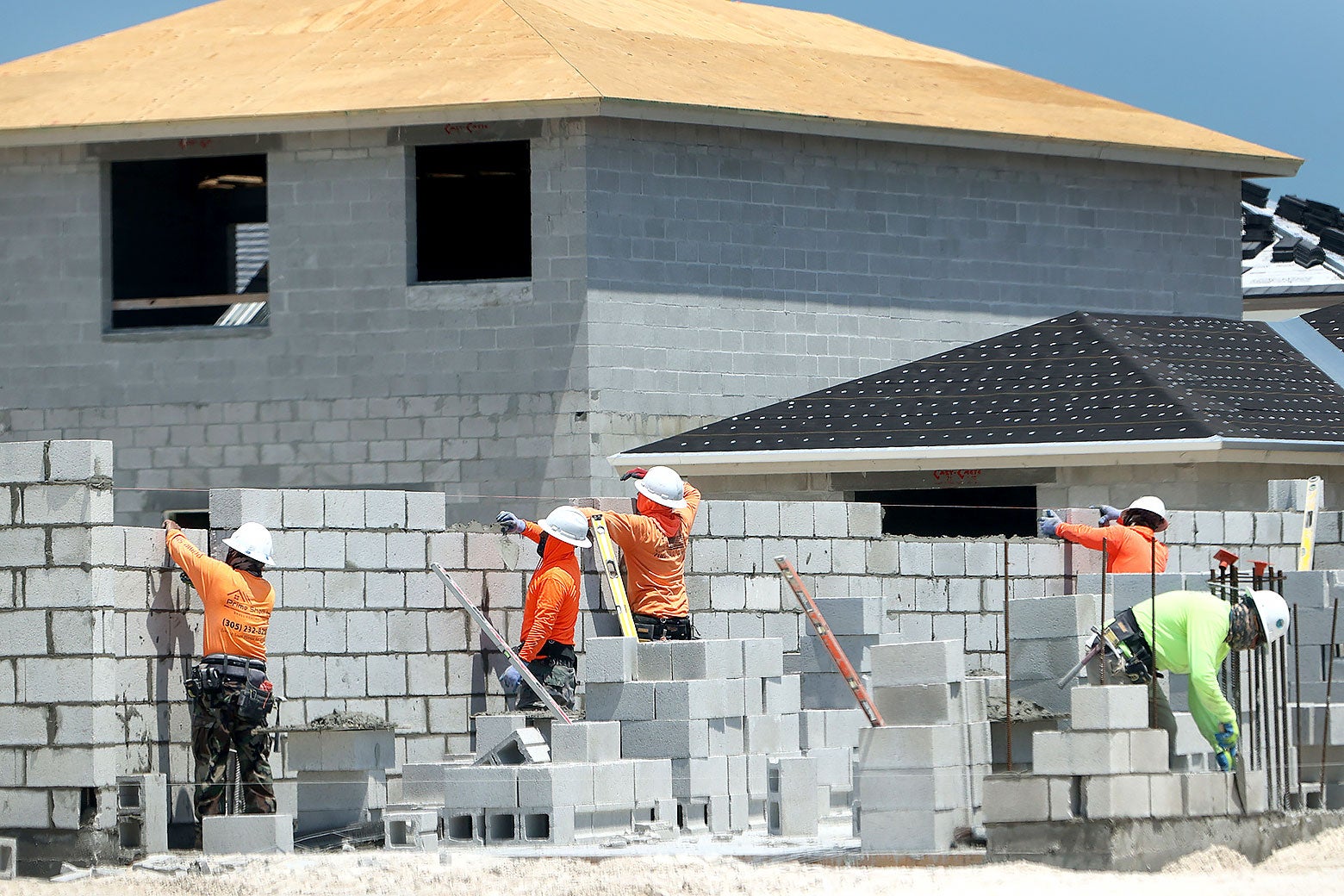Sign up for the Slatest to get the most insightful analysis, criticism, and advice out there, delivered to your inbox daily.
What is the point of the Donald Trump Tariff Show? No one seems to know, not least the man himself. Are we trying to raise a bunch of new tax revenue? Reshore manufacturing? Are tariffs simply a pretense to negotiate better trade deals? Or must we treat the spiritual malaise that comes from dependence on an endless stream of disposable consumer goods? These aims are contradictory, but that hasn’t stopped Trump and his supporters from claiming all these justifications and more.
The closest thing to a through line is the GOP’s fixation on the righteousness of a certain type of old-fashioned factory work, the sort of thing that might be represented in the popular imagination by Rosie the Riveter, if she hadn’t been flagged for removal by the Pentagon’s anti-DEI team. Who are we kidding: Trump’s hard worker is a man. The work should be dirty, difficult, and dangerous. “They wanna mine,” POTUS said last week of coal miners, whose job is one of the country’s most dangerous, marred by both on-site injuries and lifelong health problems. “You give them a penthouse on Fifth Avenue and a different kind of job, and they’d be unhappy. They want to mine coal. That’s what they love to do.” Or as Elon Musk said this weekend, “We need to shift people from low- to negative-productivity jobs in government to high-productivity jobs in manufacturing (as well as mining and refining of materials).” Make America shower after work again.
Beneath all this A.I.-generated policymaking and culture-war posturing lies a real labor-market quandary: Men without college degrees have struggled to find good jobs or hold down any job at all, a phenomenon with some big downstream effects on politics and culture, up to and including the election of Donald Trump. Addressing this has become a cause célèbre on the right, though liberals have also recognized the problem. But it’s unlikely that Trump’s chaotic tariff moves will reindustrialize the United States in any meaningful way or put men back to work.
It’s all the sillier because—to risk taking the president’s goals at face value—there is a way to put lots of American men to work with their hands. It’s a field the president should know well: construction. A giant trade, made up mostly of men, doing work that can’t be outsourced, creating housing that the country desperately needs. Instead, the president is doing his best to crush construction—even as he tries to put the country to work in toaster factories.
Trump’s yearning for manual labor is fueled mostly by the nostalgia that constitutes his entire political reason for being, but there’s a reason people like the idea. Manufacturing jobs, though far outnumbered by hospitality jobs, still pay much more—in spite of the GOP’s efforts to crush unions, worker protections, and so on. Still, they’re distant enough from most Americans’ reality in 2025 that when Ron DeSantis ran for president, he identified not as the son of a steelworker but as the grandson of a steelworker. Surveys show everyone wants more factory jobs; few people want to give up their own job to work in a factory. (Like the old Onion headline: “98 Percent of U.S. Commuters Favor Public Transportation for Others.”)
In the Washington Post this week, Rotimi Adeoye referred to Trump’s tariff philosophy as “MAGA Maoism”:
Like the Chinese Cultural Revolution, it glorifies physical labor as moral purification, only now the purification is from the supposed “wokeness” of desk work, filtered through TikTok, X and Twitch. It’s not about creating jobs. It’s about creating vibes: strong men doing hard things, reshared until they become ideology. As one MAGA influencer put it, “Men in America don’t need therapy. Men in America need tariffs and DOGE. The fake email jobs will disappear.”
The philosophy manages to be both misogynistic and misandrist all at once. The office is an inane and emasculating environment ruled by a “Gen Z boss in a mini”; men are apes who can only find fulfillment working with their hands.
This proposed American downskilling makes for good right-wing revenge porn. Treasury Secretary Scott Bessent argued the tariffs would work in concert with Elon Musk’s mass layoffs of federal workers, saying this week, “That will give us the labor that we need for the new manufacturing.” Maybe when Trump shuts down NYU we can reopen the Triangle Shirtwaist Factory, which is currently being used as classroom and laboratory space.
My colleague Nitish Pahwa has an excellent rundown of the feasibility of reshoring manufacturing, which concludes that: No, Donald Trump will not get Nikes or iPhones made in the United States anytime soon. Not that most of our outsourced manufacturing would fit with the right-wing vision of men’s work anyway: See this apparently Chinese-made A.I.-generated video that imagines Americans back at the jobs that went overseas a half-century ago.
The irony is, Trump actually had a pretty good shot at putting lots of men back to work literally swinging a hammer—or more realistically, holding a nail gun. Construction is that rare field of building things that can’t be moved overseas. As Matt Yglesias noted in a Slow Boring post last week, it pays even more than the factory. In his article “YIMBYism as Industrial Policy,” Yglesias imagines a construction boom unleashed by land use reform, with spillover effects for adjacent U.S.-based industries, like furniture. A boost for modular construction (which Canada is trying to create) would even create new factories. Construction fits Trump’s mission of giving men fulfilling careers: The industry is 90 percent male, and employs about 20 times more people than mining. But more importantly, it creates more housing, which is good, as opposed to coal, which is bad.
But Trump could not have concocted a more hostile set of policies for construction work. Nobody’s making money in the stock market this year, but one investment has been worse than almost all the rest: U.S. homebuilders. A combination of stubbornly high mortgage rates, volatile tariff policy, and efforts to deport the labor force has made it a hard time to build. Over the past six months, ETFs of homebuilder stocks are down 25 to 30 percent, compared with 10 percent for the S&P 500.
Even before you take interest rates into account (both builder and buyer are affected), the administration’s attack on labor and materials has made building things much more expensive. The New York Times recently estimated the administration’s policies might increase the cost of labor by 16 percent and materials by 31 percent on a high-end home, increasing the total cost by 20 percent. One man’s cost of labor is another man’s higher salary, of course, but the effect has been a general slowdown across the industry and less work for everyone.
Lobbyists for developers are having trouble keeping up with what’s going on, let alone responding to it. In March, the National Association of Home Builders announced they had “worked with the White House” to ensure that Canadian softwood lumber—which makes up the frame of your typical American house or small building—had been exempted from that week’s tariff blitz. A month later, just as the president was walking back “Liberation Day” last week, the Commerce Department decided it would raise the import tariff on Canadian lumber to 35 percent.
Of course, it would be nice to live in a world where men could work at skincare companies and women on construction sites. But if the American email class must be put to work with our hands, I’d rather be framing houses than assembling air conditioners.

